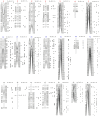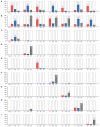Development of Sequence-Tagged Site Marker Set for Identification of J, JS, and St Sub-genomes of Thinopyrum intermedium in Wheat Background
- PMID: 34249056
- PMCID: PMC8261300
- DOI: 10.3389/fpls.2021.685216
Development of Sequence-Tagged Site Marker Set for Identification of J, JS, and St Sub-genomes of Thinopyrum intermedium in Wheat Background
Abstract
Thinopyrum intermedium (2n = 6x = 42, JJJSJSStSt) is one of the important resources for the wheat improvement. So far, a few Th. intermedium (Thi)-specific molecular markers have been reported, but the number is far from enough to meet the need of identifying alien fragments in wheat-Th. intermedium hybrids. In this study, 5,877,409 contigs were assembled using the Th. intermedium genotyping-by-sequencing (GBS) data. We obtained 5,452 non-redundant contigs containing mapped Thi-GBS markers with less than 20% similarity to the wheat genome and developed 2,019 sequence-tagged site (STS) molecular markers. Among the markers designed, 745 Thi-specific markers with amplification products in Th. intermedium but not in eight wheat landraces were further selected. The distribution of these markers in different homologous groups of Th. intermedium varied from 47 (7/12/28 on 6J/6St/6JS) to 183 (54/62/67 on 7J/7St/7JS). Furthermore, the effectiveness of these Thi-specific markers was verified using wheat-Th. intermedium partial amphidiploids, addition lines, substitution lines, and translocation lines. Markers developed in this study provide a convenient, rapid, reliable, and economical method for identifying Th. intermedium chromosomes in wheat. In addition, this set of Thi-specific markers can also be used to estimate genetic and physical locations of Th. intermedium chromatin in the introgression lines, thus providing valuable information for follow-up studies such as alien gene mining.
Keywords: STS markers; Thinopyrum intermedium; chromosome identification; physical location; specificity.
Copyright © 2021 Qiao, Liu, Li, Li, Yu, Liu, Li, Liu, Ren, Zhang, Zhang, Yang and Chang.
Conflict of interest statement
The authors declare that the research was conducted in the absence of any commercial or financial relationships that could be construed as a potential conflict of interest.
Figures






Similar articles
-
Characterization of New Wheat-Thinopyrum intermedium Derivative Lines with Superior Genes for Stripe Rust and Powdery Mildew Resistance.Plants (Basel). 2024 Aug 22;13(16):2333. doi: 10.3390/plants13162333. Plants (Basel). 2024. PMID: 39204770 Free PMC article.
-
Molecular cytogenetics and development of St-chromosome-specific molecular markers of novel stripe rust resistant wheat-Thinopyrum intermedium and wheat-Thinopyrum ponticum substitution lines.BMC Plant Biol. 2022 Mar 12;22(1):111. doi: 10.1186/s12870-022-03496-x. BMC Plant Biol. 2022. PMID: 35279089 Free PMC article.
-
Physical mapping of chromosome 7J and a purple coleoptile gene from Thinopyrum intermedium in the common wheat background.Planta. 2021 Jan 5;253(1):22. doi: 10.1007/s00425-020-03552-6. Planta. 2021. PMID: 33399998
-
Detection of alien chromatin introgression from Thinopyrum into wheat using S genomic DNA as a probe--a landmark approach for Thinopyrum genome research.Cytogenet Genome Res. 2005;109(1-3):350-9. doi: 10.1159/000082419. Cytogenet Genome Res. 2005. PMID: 15753596 Review.
-
Research progress in BYDV resistance genes derived from wheat and its wild relatives.J Genet Genomics. 2009 Sep;36(9):567-73. doi: 10.1016/S1673-8527(08)60148-4. J Genet Genomics. 2009. PMID: 19782958 Review.
Cited by
-
Characterization of New Wheat-Thinopyrum intermedium Derivative Lines with Superior Genes for Stripe Rust and Powdery Mildew Resistance.Plants (Basel). 2024 Aug 22;13(16):2333. doi: 10.3390/plants13162333. Plants (Basel). 2024. PMID: 39204770 Free PMC article.
-
Molecular and Cytogenetic Identification of Wheat-Thinopyrum intermedium Double Substitution Line-Derived Progenies for Stripe Rust Resistance.Plants (Basel). 2022 Dec 21;12(1):28. doi: 10.3390/plants12010028. Plants (Basel). 2022. PMID: 36616156 Free PMC article.
-
Molecular cytogenetics and development of St-chromosome-specific molecular markers of novel stripe rust resistant wheat-Thinopyrum intermedium and wheat-Thinopyrum ponticum substitution lines.BMC Plant Biol. 2022 Mar 12;22(1):111. doi: 10.1186/s12870-022-03496-x. BMC Plant Biol. 2022. PMID: 35279089 Free PMC article.
-
Bacillus subtilis Strain YJ-15, Isolated from the Rhizosphere of Wheat Grown under Saline Conditions, Increases Soil Fertility and Modifies Microbial Community Structure.Microorganisms. 2024 Oct 6;12(10):2023. doi: 10.3390/microorganisms12102023. Microorganisms. 2024. PMID: 39458332 Free PMC article.
-
Identification and introgression of a novel leaf rust resistance gene from Thinopyrum intermedium chromosome 7Js into wheat.Theor Appl Genet. 2023 Oct 24;136(11):231. doi: 10.1007/s00122-023-04474-z. Theor Appl Genet. 2023. PMID: 37875643
References
LinkOut - more resources
Full Text Sources
Other Literature Sources

